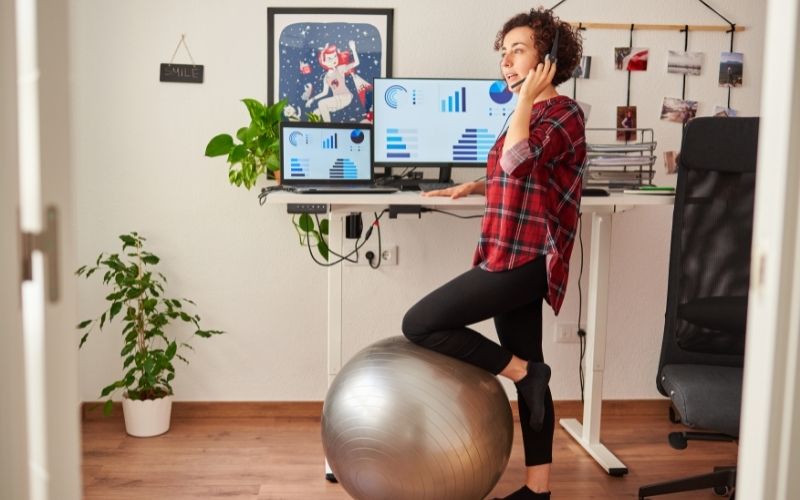We know standing desks are good for your back. They keep your posture correct and stop you from slouching down in a comfy office chair. You might even be able to get a doctor’s note or prescription for a standing desk; they’re just that helpful.
But how are standing desks for knee health? After all, you’re putting a lot of weight on your knees by working on your feet.
Standing desks can cause some knee problems, but only if you don’t use the standing desk correctly. Let’s break down how standing desks can affect your knees, how to stand properly, and everything else you might need to know.
Table of Contents
Is Standing Better for Knees?
Standing has a lot of benefits. It burns more calories than sitting, takes pressure off your lower back, and encourages us to walk around more. However, standing also puts a lot of weight on your knees if you don’t listen to your body.

Standing properly can be beneficial for the knees. It straightens your legs up and encourages healthy circulation. When blood flow in the knees is limited, it can lead to numbness or pain, worsening any pre-existing conditions.
Standing also encourages you to move more. It’s far more convenient to take a little walk around the office if you’re already on your feet. Moving your knees is a good way to keep them flexible and healthy, so we strongly encourage incorporating gentle exercise into your daily routine.
Is Standing Better than Sitting for Knee Pain?
It depends on what kind of knee pain you experience.

Sitting isn’t inherently evil. It lets our body relax and rest and takes the weight off of our lower body. If it’s painful to stand, you should listen to your body and take a day or two off standing a lot.
However, sitting too much can worsen knee pain. Your body isn’t designed to stay still for incredibly long periods, so your knees may weaken or stiffen if they aren’t used for a few hours. Sitting in the wrong position will make this even worse.
Think about how you feel when you stand up after a long movie or boring meeting; it’s a little painful at first, right? That’s what sitting for too long does to you.
So, what’s better for knee pain, standing or sitting? Well, the short answer would be sitting. If you stand correctly and switch up positions regularly, you’re less likely to develop knee pain.
Are Standing Desks Good for Your Knees?
Standing desks can be good for your knees, but they can also be harmful to them. It all depends on how you use them.
In order to benefit from a standing desk, you need to be aware of how your body feels and the ways to stand to keep your knees healthy.

You should be mindful of your weight distribution. Your knees are already carrying your entire body on them; the last thing they need is an uneven amount of weight.
Have a look at your body. Is it leaning? Are you anchoring yourself on one leg more than the other? This can cause knee issues. You want your feet and knees to be grounded and hold even amounts of weight.
Leaning on furniture, especially your desk, is another big no-no. This is going to make your body unbalanced, which may lead to soreness. Your knees may feel relieved the first few minutes of leaning up against a table, but that won’t last very long.
A standing desk can help your knees if you stand in dynamic poses that ensure you aren’t stiff and still for hours on end. Moving is incredibly important. You want to change up positions and keep your legs away and active throughout the day.
Passive standing occurs when you’re standing but forget to check in with your body. In many ways, it isn’t very different from sitting. You may slouch, lean on one leg, and relax a lot more than you should to stand ergonomically.
Having the right shoes to stand will also improve your knee health. Remember, your whole body is connected, so if you experience pain in your feet, it may spread up to your knees and cause more serious problems.

We recommended going for shoes with padding and support. Sneakers with thick soles or house shoes with fluffy and comfortable soles are both good choices.
If you have the choice whether to stand on carpet or hardwood flooring, opt for the carpet. It’s softer and more forgiving.
Finally, make sure not to lock your knees when standing. This is going to stiffen them almost immediately, and you’ll quickly become uncomfortable.
Your knees should be strong but somewhat relaxed. If you find yourself buckling your knees, you may need to sit down and give your knees and legs a rest.
Is a Standing Desk Bad for Your Legs?
A standing desk can be bad for your legs, but it can also be good for them!

It is more common for people to experience lower body pain when using a standing desk. They are using the same muscles in a relatively similar stance repeatedly, so some soreness is natural.
Some people like that feeling since it makes them feel like they’re working out and pushing their bodies, but that’s not the case.
Standing desks move up and down for a reason. They give you the option to sit or stand, and make it convenient to switch between the two. Your legs will suffer if you don’t give them enough breaks throughout the day.
When standing, your desk should be at elbow height and your legs should be relaxed but active. Bending or stiffening your legs too much is bad for them, so avoid this.
How Long Should You Stand at a Standing Desk per Day?
It is very important to know how long to stand every day. We can only imagine the excitement people feel when they first receive their standing desks. They want to set them up and see if they can spend their entire day on their feet!
While that may sound like a good idea, in theory, you’ll soon discover it’s not a very practical one. Everyone has their own limits for how long they can stand without becoming uncomfortable.

You need to take your time and figure out how long you can stand comfortably and healthily.
Experts recommend you start by standing for 30 to 60 minutes a day when you first get to your desk. Be mindful of how your feet and legs feel. Are you distributing your weight correctly? Are you buckling your knees?
After a week or so, you can slowly introduce more standing time into your routine. By the end, you should be able to stand for 30 minutes every hour. Some people like to set a timer, so they don’t sit or stand for too long.

When you’re standing, remember not to be completely still. This will hinder your circulation and start to cause stiffness and soreness. Moving around could include walking to fix yourself a hot beverage or taking a stroll down the office corridor to ask a colleague about an invoice or what they’re doing next weekend.
The biggest thing to keep in mind is that you aren’t better or worse for standing more or less than someone else. We all have our limits and respecting them is how we maintain healthy and happy bodies.
A Note on Ergonomic Office Chairs
No good standing desk is complete without a supportive ergonomic office chair to sit in when you aren’t standing. Office hours are long and unforgiving, so you need your spine and hips to be supported all day long.

Look for a chair with a slopped (or waterfall) seat edge. This will prevent your knees from hanging off a sharp edge. You also want plenty of lumbar support to maintain correct posture throughout the day.
Finally, make sure your chair is at the correct height. Your feet should be able to touch the ground, but you don’t want your knees to be taller than your hips.
To Wraps Things Up
Standing desks can be good for your knees, as long as you use them correctly. Practicing proper posture and moving around regularly will help make using a standing desk a positive experience.
If you’re dealing with serious knee pain, do not try to use your standing desk. Take a few days to rest so you don’t worsen your symptoms. However, we encourage you to walk around every now and then to encourage blood flow.
When you get a standing desk, take your time getting used to it. Enjoy going back and forth between sitting and standing so you don’t push yourself too hard. An automatic standing desk makes transitioning between the two positions more convenient.
Have you found that standing desks helped or hurt your knees? What’s your favorite standing position to protect your knees? Let us know in the comments below!
Good luck!

My name is Vance, and I am the owner of To Ergonomics. Our mission is to improve your workflow by helping you create a supportive and welcoming environment. We hope that you’ll find what you’re looking for while you’re here.

